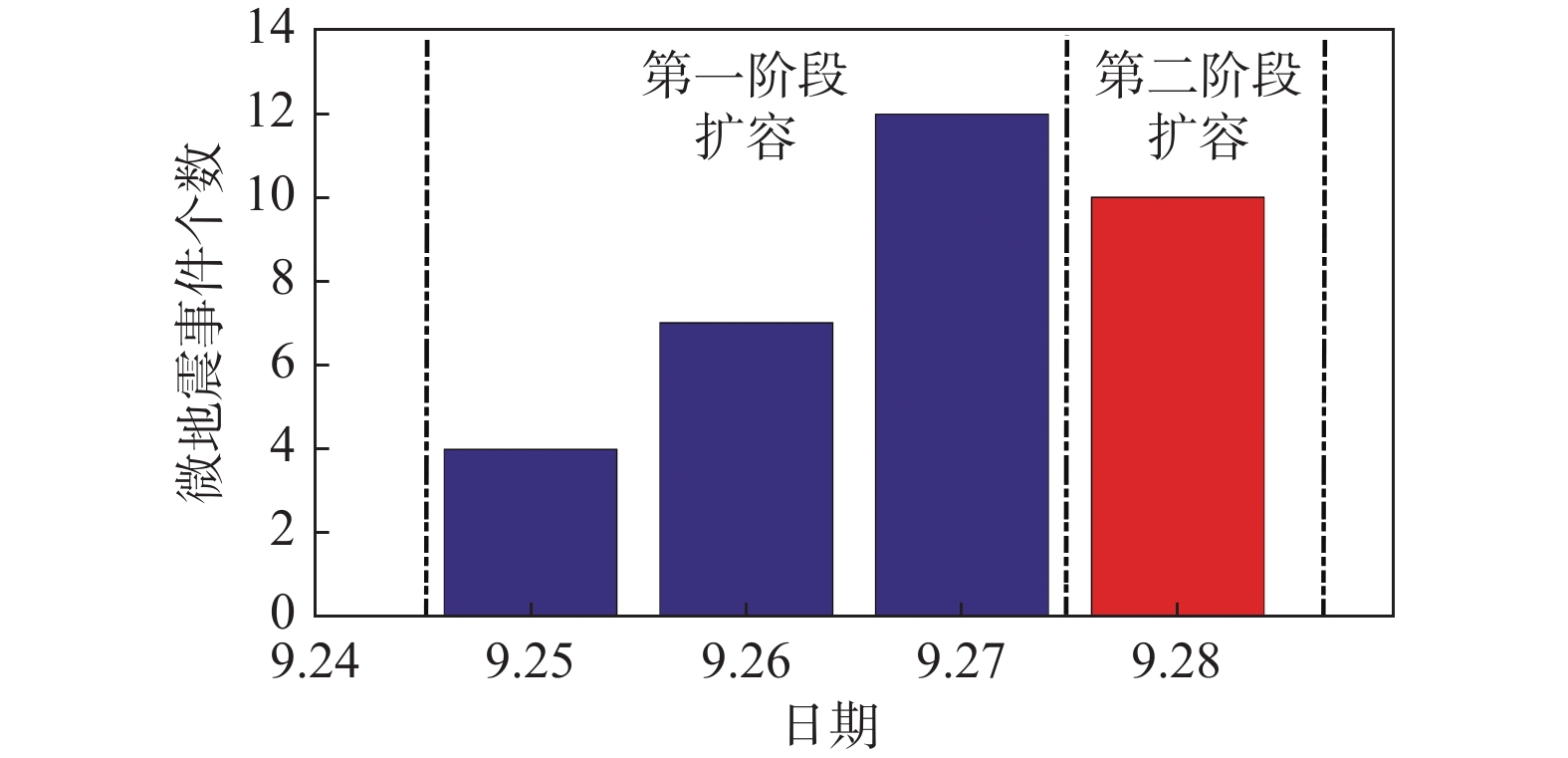Application of Time Reversed Imaging in Downhole Microseismic Monitoring for Fast SAGD Start–Up Enhancement of Heavy Oil Reservoir in Fengcheng Oil Field
-
摘要:
蒸汽辅助重力泄油(SAGD)快速预热技术利用短时间的注入高压蒸汽在生产井和注入井之间形成一个高孔隙度和高渗透率的扩容蒸汽腔,其几何形态与扩展规律可由微地震技术进行监测和描述。笔者选取风城重油油田的一组SAGD快速预热注入与生产井组进行井下微地震监测,采用三维弹性波逆时干涉震源定位算法获取弱微地震事件的空间分布,定量计算高温蒸汽注入期间形成蒸汽腔体的长度、宽度、高度、方位和扩容体积,对蒸汽腔体几何形态和震级能量分布的动态变化进行分析,探讨蒸汽腔前缘在深度上针对非均质性夹层的延伸趋势与形态。研究结果表明,注入井与生产井之间已经联通,且扩容区域已部分延伸至油层底界面。此外,注入井上方储层产生了较多的微地震事件,表明本次施工已击破注入井上方的非均质物性夹层,完成了注入井上方储层改造的任务。
Abstract:Fast SAGD start−up enhancement technique injects the high−pressure steam in short time to build a high−temperature steam chamber with high porosity and permeability. In this study, downhole microseismic monitoring was performed in a fast SAGD start−up enhancement well group of heavy oil reservoir in Fengcheng oil field to delineate the geometric and dynamic propagation characteristics of formed steam chamber. Time reversed imaging method was applied to obtain the weak event locations with high accuracy. The quantitative estimation of length, width, height, azimuth and volume of the steam chamber was also estimated based on the event locations. The variation of steam chamber geometric and energy distribution with dates were also analyzed. The propagation characteristics of steam chamber front in depth direction respect to heterogeneous interlayer was also studied. The microseismic monitoring results demonstrates that the injection well and production well has been connected and the expansion area has partially extended to the bottom of the oil layer interface. In addition, amount of microseismic events were found above the injection well which suggests the steam has break the heterogeneous interlayer. Therefore, the reservoir has been successfully stimulated. Finally, the fitting relationship between steam chamber geometry characteristics and injection dates has been obtained based on the microseismic monitoring results, which provides significantly theoretical and practical foundation for the design and optimization of fast SAGD start−up enhancement in the studied area.
-

-
表 1 SAGD蒸汽腔几何参数随时间变化表
Table 1. Geometric parameters of SAGD steam chamber with various date
日期 蒸汽腔网络长(m) 蒸汽腔网络宽(m) 蒸汽腔网络高(m) 蒸汽腔
网络方位累积事
件个数蒸汽腔体积(m3) 9月25日 215.14 51.64 1.04 NE113.78° 4 0.11×105 9月26日 296.26 100.91 2.31 NE98.10° 11 0.69×105 9月27日 570.32 107.04 5.24 NE95.99° 23 3.20×105 9月28日 570.19 127.85 10.56 NE95.21° 33 7.70×105 -
[1] 董宏, 何万军, 蒋雪峰, 等. 微地震监测在新疆稠油SAGD开发中的应用[J]. 特种油气藏, 2017, 24(3): 114-118 doi: 10.3969/j.issn.1006-6535.2017.03.022
DONG Hong, HE Wanjun, JIANG Xuefeng et al. Application of microseismic monitoring in heav-oil SAGD development in Xinjiang [J], Special oil and gas reservoirs, 2017, 24(3): 114-118. doi: 10.3969/j.issn.1006-6535.2017.03.022
[2] 何文军, 吴和源, 杨森, 吴伟涛, 李娜, 白玉彬, 王然, 赵毅, 戚艳平, 赵辛楣. 准噶尔盆地玛湖凹陷风城组页岩油储层岩相划分与类型评价[J]. 西北地质, 2023, 56(1): 217-231
HE Wenjun, WU Heyuan, YANG Sen, WU Weitao, LI Na, BAI Yubin, WANG Ran, ZHAO Yi, QI Yanping, ZHAO Xinmei. Lithofacies Division and Type Evaluation of Shale Oil Reservoir in Fengcheng Formation of Mahu Sag, Junggar Basin[J]. Northwestern Geology, 2023, 56(1): 217-231.
[3] 李萌, 诱发地震监测数值模拟与反演方法[M]. 北京: 中国石化出版社, 2020
LI Meng. Numerical simulation and inversion methods for induced seismic monitoring [M]. Beijing: Sinopec Press, 2020.
[4] 李萌, 陶果, 王华, 等. 微地震逆时聚焦定位算法的模拟实验研究[J]. 中国石油大学学报(自然科学版), 2016, 40(5): 59-71
LI Meng, TAO Guo, WANG Hua, et al. Parametric optimization on locating microseismic events with reverse time imaging[J]. Journal of China University of Petroleum (Edition of Natural Science), 2016, 40(5): 59-71.
[5] 李彦平, 张平, 揣金海, 李华, 孙鹏. 超稠油油藏转小井距蒸汽驱条件及时机[J]. 西北地质, 2003, 36(4): 74-78
LI Yan-ping, ZHANG Ping, CHUAI Jin-hai, LI Hua, SUN Peng. The study on switching to steamflooding conditions and opportunity from steam stimulation in super heavy oil reservoirs[J]. Northwestern Geology, 2003, 36(4): 74-78.
[6] Maxwell S. 非常规储层水力压裂微地震成像[M]. 北京: 石油工业出版社, 2015.
Maxwell S. Microseismic imaging of hydraulic fracturing: improved engineering of unconventional shale reservoirs [M]. Beijing: Petroleum Industry Press, 2015.
[7] 宋维琪. 微地震监测新技术与新方法[M]. 青岛: 中国石油大学出版社, 2014
SONG Weiqi. The new technology and method for microseismic monitoring [M]. Qingdao: China University of Petroleum Press, 2014.
[8] 杨瑞召, 李德伟, 庞海玲, 等. 页岩气压裂微地震监测中的裂缝成像方法[J]. 天然气工业, 2017, 37(5): 31-37
YANG Ruizhao, LI Dewei, PANG Hailin et al. Fracture imaging of the surface based microseismic monitoring in shale gas fracking: Methods and application [J]. Natural Gas Industry, 2017, 37(5): 31-37.
[9] Artman B, Podladtchikov I, Witten B. Source location using time‐reverse imaging[J]. Geophysical Prospecting, 2010, 58(5): 861-873. doi: 10.1111/j.1365-2478.2010.00911.x
[10] Douma J, Snieder R. Focusing of elastic waves for microseismic imaging[J]. Geophysical Journal International, 2015, 200(1): 390-401.
[11] Gajewski D, Tessmer E. Revere modeling for seismic events characterization [J]. Geophysical Journal International, 2005, 163: 276-284. doi: 10.1111/j.1365-246X.2005.02732.x
[12] Li L, Tan J, Wood D A, et al. A review of the current status of induced seismicity monitoring for hydraulic fracturing in unconventional tight oil and gas reservoirs[J]. Fuel, 2019, 242(APR. 15): 195-210.
[13] Li M, Li H, Tao G, Ali, M. , Guo, Y. Microseismic event location using multi-scale time reversed imaging [J]. Journal of Petroleum Science and Engineering, 2019, 174: 144-160. doi: 10.1016/j.petrol.2018.11.015
[14] Li M, Shen H, Guo Y, et al. Locating microseismic events using multiplicative time reversal imaging based on decoupled wavefields in 2D VTI media: Theoretical and synthetic cases studies[J]. Journal of Petroleum Science and Engineering, 2021, 202(4): 108547.
[15] Nakata N, Beroza G C. Reverse time migration for microseismic sources using the geometric mean as an imaging condition[J]. Geophysics, 2016, 81(2): KS51-KS60. doi: 10.1190/geo2015-0278.1
[16] Wang H, Li M, Shang X. Current developments on micro-seismic data processing[J]. Journal of Natural Gas Science and Engineering, 2016.
[17] Zhu T. Time-reverse modeling of acoustic wave propagation in attenuating media[J]. Geophysical Journal International, 2014, 197(1): 483-494. doi: 10.1093/gji/ggt519
-




 下载:
下载:








